#aircraft design company
Note
re: your tags because I'm curious and google is only providing a history book about WW1 naval battles - what's castles of steel?
My apologies for this belated response, but here it is:
Castles of Steel (tagline: Lesbians Good, Imperialism Bad) is a quest hosted on SufficientVelocity. Set in alt-history Japan starting in the year 1909, it chronicles the adventures of Princess Arisukawa Haruna as she makes history as the first woman to join the imperial navy. Based on the fact I tagged it on a post about how war is never clean, you can get a sense of how that goes.
It's mostly concerned with sea battles, which do tend to be cleaner than land ones (the one land battle Haruna gets involved in, she's given a not-particularly good map, and the ground is torn up and communications are bad, so she winds up defending a hill that may or may not be the one she was assigned to). But the story is still very aware that this is a war being fought over and on colonial possessions, that neither side particularly cares about treatment of civilians, and that wartime pressure is sliding alt!Japan into facism.
To give an example of how bad it gets, early on Haruna fails a roll to convince a superior officer that trotting out an imperial princess for a PR shoot in an unhappy occupied city is a bad idea, and when this predictably sparks a riot, well, when all you have is a troop of soldiers, everything looks like a combat scenario. The option the thread picked was Fix Bayonets (as opposed to just opening fire), but still:
Once the first blood was drawn, once the screaming started, order broke down almost completely. To the men on either side of the incident, it looked like their formation had been breached, that a brawl had broken out. You tried to call a halt, but nobody could hear you. A cobblestone struck a soldier, and the one next to him thrust his rifle forward to cover the gap, catching a man through the gut with his blade. His comrades reversed their weapons as well, convinced the fighting had turned deadly, and simply pressed into the crowd blades-first. The screaming got louder as people tried to scramble away and others fell to the ground to be trampled in the panic.
It worked. They were moving, now. The trucks were almost in reach. You stepped over a body as you moved, a student holding a sign in a death grip. You realized he wasn't dead yet when his hand closed on your boot. You managed not to shriek in surprise and hurriedly tried to shake him off only to stumble over another body on the cobbles. A woman clutching her belly and groaning as she tried to staunch the blood pooling on the cobblestones around her. The blood that was staining the pretty dress in Akitsukuni white and blue that she wore. She looked up at you for a moment, and you wondered what she thought of you.
and afterwards:
You remembered when you had finally gotten into the Army outpost and you had gone to the washroom, there had been blood on your boots. You'd been sick there, alone, where no one could see your weakness. This wasn't what it was supposed to be like. You were supposed to stand on the bridge of a steel castle and exchange blows with an equal opponent seeking to do harm to your nation, not tell scared young men to stab angry students.
And then there pretty much aren't consequences for this, she gets comforted for being in such a scary situation and praised for how she handled it, the whole incident gets blown over because no one really cares about the deaths of protestors in an occupied city. She just has to keep
This story is a companion to an earlier one called Aircraft Design Company, which is maybe the purest example of "Peace Activist Has To Admit Barrett .50 Caliber Sniper Rifle Is Pretty Cool" I've read. The story was initially started to playtest the author's TTRPG system for early aviation design, then grew a plot that goes increasingly into "war is hell". The protagonist's boyfriend is a pilot who becomes a flying ace over the course of the story, and we get periodic interludes from his perspective as things get bloodier in the air and on the ground, as the other soldiers around him get more desperate and dangerous to the civilian "servants" of their occupied territory, and as he develops PTSD.
There's one great scene where he gets into a dogfight, and is just utterly done with violence and killing, and so he non-fatally shoots out the other guy's engine, and then signals frantically to him to surrender and land. And there's a moment of tension, and then the other pilot agrees, and it's this rare uplifting moment of camaraderie of the skies, even on opposing sides. And then the other pilot lands and promptly gets shot by Japanese ground forces who don't notice or care that he's trying to surrender.
¯\_(ツ)_/¯
Anyway, at one point the protagonist gets a letter back from him reading:
This war has eroded everything I have. I'm a machine no different from the ones you build for me. I wake up in the early morning and sit on a chair behind the lines with binoculars until nightfall. When I see an enemy machine, I climb into my Dragonfly and go to kill him.
They don't make me fly regular missions anymore. I am just a killer now, an assassin. I fly five, six times a day sometimes.
It is hard for me to say this, but I have come to resent you, and to resent the weapons you have built me. I have come to hate how easy it is to line my guns up on an aircraft. How easy it is to kill the stupid young boys they send against me. I hate how the Dragonfly will nimbly pull me from the enemy's sights and keep me flying another day.
I have found myself thinking I would rather have died quickly, six months ago.
and then it's time for another vote on aircraft mechanics!
6 notes
·
View notes
Text
Aviation Flying High on Alternative Sources of Power - Technology Org
New Post has been published on https://thedigitalinsider.com/aviation-flying-high-on-alternative-sources-of-power-technology-org/
Aviation Flying High on Alternative Sources of Power - Technology Org
As the aviation industry moves toward net zero emissions by 2050, sustainable aviation fuel is one of the many alternatives being developed.
A flying airplane. Image credit: Willy Wo via Unsplash, free license
November 28, 2023, was a landmark day for the international airline industry. It marked the first time a jet airliner powered by 100 percent sustainable aviation fuel flew from London to New York.
The Virgin Atlantic flight, which carried no paying passengers but did have an airline executive, a politician and Virgin founder Sir Richard Branson onboard, flew using a fuel made up mostly of waste fats and plant sugars.
Sustainable aviation fuel is one of the many alternative fuels and propulsion technologies being developed as the aviation industry moves toward net zero emissions by 2050.
After electricity and heat, transport is the sector with the highest carbon dioxide (CO2) emissions. Aviation counts for 2 percent of Co2 emissions globally.
Aviation is crucial not only for global passenger movement but also global supply chains. While civil aviation nearly disappeared during the COVID-19 pandemic, cargo flights distributed much-needed disease controlling equipment and vaccines. The impact of fewer passenger flights was felt across supply chains as a lot of regular cargo is transported as belly capacity in passenger flights.
Aviation bodies such as the International Air Transport Association and International Civil Aviation Organization have committed to decarbonising the industry by 2050.
There are many ways to tackle aviation emissions.
New aircraft designs to reduce noise and pollution have been developed for decades. In recent years, however, new technologies for decarbonising aircraft have been emerging and accelerating.
Sustainable aviation fuels to electric and hydrogen flight, as well as hybrids, are all being researched, designed, tested and commercialised.
Airlines prefer sustainable fuel currently as it can be used in existing aircraft without alterations. But it is not the only long term solution as questions linger over emissions during its production, challenging supply chains, competition for sustainable produced feedstock and worries about deforestation for cultivating feedstock for sustainable fuels.
Sustainable fuels alone will not decarbonise aviation. Other solutions for a more sustainable way of flying are aircraft powered by electricity and hydrogen.
Electric flying
Electric flying has made significant progress with, for example, Pipistrel certifying the first fully electric aircraft, the Velis Electro in 2020. Drones for cargo, and in the future passenger transport, have been betting on electric propulsion as well. Volocopter, a fully electric powered drone for passenger transport, received approval for a production line in 2023.The main challenge for electric aircraft is range due to the limited capacity of batteries.
Electric aircraft can be a solution for short-haul but will not decarbonise medium to long-haul flights. Other important factors to consider with electric aircraft are the production of renewable energies at scale and upgrades of the distribution grid especially in regional and remote areas.
Lifecycle analyses are also needed to consider emissions for the whole life of an electric aircraft, which includes battery production and battery life to determine how much emissions can be reduced in comparison to traditional flight.
Acknowledging the challenges around the short range of electric flight, numerous start-ups are moving to a hybrid model using hydrogen and electricity. Examples include Dovetail Electric Aviation supported by regional airline Rex, and ZeroAvia supported by big names such as Airbus.
Others are looking at an all-hydrogen solution such as Stralis by retrofitting existing aircraft but also designing a new aircraft that would cater for the medium-haul sector with an estimated entry into service in 2030 with a range of 3,000km. In the passenger drone sector, companies such as AMSL Aero are also moving to a hybrid solution with ranges of up to 1,000km.
Hydrogen
An all-hydrogen solution is promising as a long-term long-haul solution for civil aviation but has its own challenges. One is the increase of the size of fuel tanks due to hydrogen’s properties. This not only changes the aircraft designs but also comes with challenges at airports with limited space. Questions about supply chains and possible negative climate effects of contrails are other obstacles.
It is not only the start-ups that are active in sustainable aviation. Manufacturers such as Airbus and Rolls Royce are also working towards more sustainable solutions. Airbus plans to have the first commercial hydrogen-powered aircraft ready by 2035 and Rolls Royce is actively working with partners such as budget carrier easyJet on hydrogen and hybrid propulsion.
Commercial airlines such as easyJet, Air New Zealand and Rex have all made some headway into the market. Rex is an investor in Dovetail Electric Aviation, easyJet is working with Rolls Royce, and Air New Zealand recently bought its first all-electric aircraft. Meanwhile, Emirates and Qantas have established climate funds.
Some of the main challenges with net zero aviation are the sustainable production of the fuel, understanding the lifecycle of emissions, understanding the effect on the climate of other emissions than Co2 and contrails, the limited ranges of electric powered flights, longer aircraft design due to large size hydrogen fuel tanks, infrastructure and sustainable supply chains of electricity and hydrogen especially to more regional and remote areas, high costs of new technology, and skilling up the workforce to work in these emerging fields.
However, with aviation bodies, manufacturers, airlines and entrepreneurs working together on keeping the world moving, one may hope that flying on significantly reduced emissions will be a reality sooner than later.
Source: UNSW
You can offer your link to a page which is relevant to the topic of this post.
#2023#air#aircraft#aviation#batteries#battery#battery life#betting#carbon#Carbon dioxide#challenge#Chemistry & materials science news#climate#CO2#Companies#comparison#covid#deforestation#Design#Disease#drone#drones#EasyJet#effects#electric aircraft#electricity#Emissions#Energy & fuel news#equipment#flight
0 notes
Text
दिल्ली एयरपोर्ट पर इंडिगो विमान के इंजन में लगी आग, सभी यात्री सुरक्षित । ये फ्लाइट दिल्ली से बेंगलुरु के लिए उड़ान भर रही थी, तभी अचानक फ्लाइट के दाहिने विंग से चिंगारी निकलने लगी । इंडिगो एयरलाइंस की फ्लाइट 6E 2131 के इस वीडियो में फ्लाइट के राइट विंग में आग की लपटें नजर आई। विमान में 177 यात्री सवार थे। इस घटना के बाद ये वीडियो सोशल मीडिया पर खूब वायरल हो रहा है।https://lnkd.in/dSkr3-A9
#Airport #IndiraGandhiInternationalAirport #IndiGoflight #indigoairlines #indigo #delhi #delhincr #delhigram #DelhiAirport #fyp #DelhiNews #indiacorenews #viralpost #viralvideo #viralvideo2022
#news#google news#update#breaking news#world news#celebrities#indigo airlines#indigo aircraft#indigo airbus 321#delhi news#best web designing company in delhi ncr#mumbai#uttar pradesh
0 notes
Text
#aircraft vhf antenna#uhf vhf antennas#antenna development engineer#vhf antennas#external wifi booster#improve wifi signal#wifi signal enhancer#antenna design company#wifi antenna booster#active antenna development
0 notes
Text
Boeing’s deliberately defective fleet of flying sky-wreckage
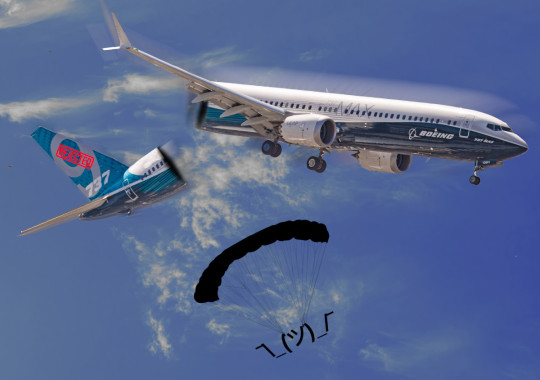
I'm touring my new, nationally bestselling novel The Bezzle! Catch me TOMORROW (May 2) in WINNIPEG, then Calgary (May 3), Vancouver (May 4), Tartu, Estonia, and beyond!

Boeing's 787 "Dreamliner" is manufactured far from the company's Seattle facility, in a non-union shop in Charleston, South Carolina. At that shop, there is a cage full of defective parts that have been pulled from production because they are not airworthy.
Hundreds of parts from that Material Review Segregation Area (MRSA) were secretly pulled from that cage and installed on aircraft that are currently plying the world's skies. Among them, sections 47/48 of a 787 – the last four rows of the plane, along with its galley and rear toilets. As Moe Tkacik writes in her excellent piece on Boeing's lethally corrupt culture of financialization and whistleblower intimidation, this is a big ass chunk of an airplane, and there's no way it could go missing from the MRSA cage without a lot of people knowing about it:
https://prospect.org/infrastructure/transportation/2024-04-30-whistleblower-laws-protect-lawbreakers/
More: MRSA parts are prominently emblazoned with red marks denoting them as defective and unsafe. For a plane to escape Boeing's production line and find its way to a civilian airport near you with these defective parts installed, many people will have to see and ignore this literal red flag.
The MRSA cage was a special concern of John "Swampy" Barnett, the Boeing whistleblower who is alleged to have killed himself in March. Tkacik's earlier profile of Swampy paints a picture of a fearless, stubborn engineer who refused to go along to get along, refused to allow himself to become inured to Boeing's growing culture of profits over safety:
https://prospect.org/infrastructure/transportation/2024-03-28-suicide-mission-boeing/
Boeing is America's last aviation company and its single largest exporter. After the company was allowed to merge with its rival McDonnell-Douglas in 1997, the combined company came under MDD's notoriously financially oriented management culture. MDD CEO Harry Stonecipher became Boeing's CEO in the early 2000s. Stonecipher was a protege of Jack Welch, the man who destroyed General Electric with cuts to quality and workforce and aggressive union-busting, a classic Mafia-style "bust-out" that devoured the company's seed corn and left it a barren wasteland:
https://qz.com/1776080/how-the-mcdonnell-douglas-boeing-merger-led-to-the-737-max-crisis
Post-merger, Boeing became increasingly infected with MDD's culture. The company chased cheap, less-skilled labor to other countries and to America's great onshore-offshore sacrifice zone, the "right-to-work" American south, where bosses can fire uppity workers who balked at criminal orders, without the hassle of a union grievance.
Stonecipher was succeeded by Jim "Prince Jim" McNerney, ex-3M CEO, another Jack Welch protege (Welch spawned a botnet of sociopath looters who seized control of the country's largest, most successful firms, and drove them into the ground). McNerney had a cute name for the company's senior engineers: "phenomenally talented assholes." He created a program to help his managers force these skilled workers – everyone a Boeing who knew how to build a plane – out of the company.
McNerney's big idea was to get rid of "phenomenally talented assholes" and outsource the Dreamliner's design to Boeing's suppliers, who were utterly dependent on the company and could easily be pushed around (McNerney didn't care that most of these companies lacked engineering departments). This resulted in a $80b cost overrun, and a last-minute scramble to save the 787 by shipping a "cleanup crew" from Seattle to South Carolina, in the hopes that those "phenomenally talented assholes" could save McNerney's ass.
Swampy was part of the cleanup crew. He was terrified by what he saw there. Boeing had convinced the FAA to let them company perform its own inspections, replacing independent government inspectors with Boeing employees. The company would mark its own homework, and it swore that it wouldn't cheat.
Boeing cheated. Swampy dutifully reported the legion of safety violations he witnessed and was banished to babysit the MRSA, an assignment his managers viewed as a punishment that would isolate Swampy from the criminality he refused to stop reporting. Instead, Swampy audited the MRSA, and discovered that at least 420 defective aviation components had gone missing from the cage, presumably to be installed in planes that were behind schedule. Swampy then audited the keys to the MRSA and learned that hundreds of keys were "floating around" the Charleston facility. Virtually anyone could liberate a defective part and install it into an airplane without any paper trail.
Swampy's bosses had a plan for dealing with this. They ordered Swampy to "pencil whip" the investigations of 420 missing defective components and close the cases without actually figuring out what happened to them. Swampy refused.
Instead, Swampy took his concerns to a departmental meeting where 12 managers were present and announced that "if we can’t find them, any that we can’t find, we need to report it to the FAA." The only response came from a supervisor, who said, "We’re not going to report anything to the FAA."
The thing is, Swampy wasn't just protecting the lives of the passengers in those defective aircraft – he was also protecting Boeing employees. Under Sec 38 of the US Criminal Code, it's a 15-year felony to make any "materially false writing, entry, certification, document, record, data plate, label, or electronic communication concerning any aircraft or space vehicle part."
(When Swampy told a meeting that he took this seriously because "the paperwork is just as important as the aircraft" the room erupted in laughter.)
Swampy sent his own inspectors to the factory floor, and they discovered "dozens of red-painted defective parts installed on planes."
Swampy blew the whistle. How did the 787 – and the rest of Boeing's defective flying turkeys – escape the hangar and find their way into commercial airlines' fleets? Tkacik blames a 2000 whistleblower law called AIR21 that:
creates such byzantine procedures, locates adjudication power in such an outgunned federal agency, and gives whistleblowers such a narrow chance of success that it effectively immunizes airplane manufacturers, of which there is one in the United States, from suffering any legal repercussions from the testimony of their own workers.
By his own estimation, Swampy was ordered to commit two felonies per week for six years. Tkacik explains that this kind of operation relies on a culture of ignorance – managers must not document their orders, and workers must not be made aware of the law. Whistleblowers like Swampy, who spoke the unspeakable, were sidelined (an assessment by one of Swampy's managers called him "one of the best" and finished that "leadership would give hugs and high fives all around at his departure").
Multiple whistleblowers were singled out for retaliation and forced departure. William Hobek, a quality manager who refused to "pencil whip" the missing, massive 47-48 assembly that had wandered away from the MRSA cage, was given a "weak" performance review and fired despite an HR manager admitting that it was bogus.
Another quality manager, Cynthia Kitchens, filed an ethics complaint against manager Elton Wright who responded to her persistent reporting of defects on the line by shoving her against a wall and shouting that Boeing was "a good ol’ boys’ club and you need to get on board." Kitchens was fired in 2016. She had cancer at the time.
John Woods, yet another quality engineer, was fired after he refused to sign off on a corner-cutting process to repair a fuselage – the FAA later backed up his judgment.
Then there's Sam Salehpour, the 787 quality engineer whose tearful Congressional testimony described more corner-cutting on fuselage repairs:
https://www.youtube.com/watch?v=PP0xhIe1LFE
Salehpour's boss followed the Boeing playbook to the letter: Salehpour was constantly harangued and bullied, and he was isolated from colleagues who might concur with his assessment. When Salehpour announced that he would give Congressional testimony, his car was sabotaged under mysterious circumstances.
It's a playbook. Salehpour's experience isn't unusual at Boeing. Two other engineers, working on the 787 Organization Designation Authorization, held up production by insisting that the company fix the planes' onboard navigation computers. Their boss gave them a terrible performance review, admitting that top management was furious at the delays and had ordered him to punish the engineers. The engineers' union grievance failed, with Boeing concluding that this conduct – which they admitted to – didn't rise to the level of retaliation.
As Tkacik points out, these engineers and managers that Boeing targeted for intimidation and retaliation are the very same staff who are supposed to be performing inspections of behalf of the FAA. In other words, Boeing has spent years attacking its own regulator, with total impunity.
But it's not just the FAA who've failed to take action – it's also the DOJ, who have consistently declined to bring prosecutions in most cases, and who settled the rare case they did bring with "deferred prosecution agreements." This pattern was true under Trump's DOJ and continued under Biden's tenure. Biden's prosecutors have been so lackluster that a federal judge "publicly rebuked the DOJ for failing to take seriously the reputational damage its conduct throughout the Boeing case was inflicting on the agency."
Meanwhile, there's the AIR21 rule, a "whistleblower" rule that actually protects Boeing from whistleblowers. Under AIR21, an aviation whistleblower who is retaliated against by their employer must first try to resolve their problem internally. If that fails, the whistleblower has only one course of action: file an OSHA complaint within 90 days (if HR takes more than 90 days to resolve your internal complaint, you can no have no further recourse). If you manage to raise a complaint with OSHA, it is heard by a secret tribunal that has no subpoena power and routinely takes five years to rule on cases, and rules against whistleblowers 97% of the time.
Boeing whistleblowers who missed the 90-day cutoff have filled the South Carolina courts with last-ditch attempts to hold the company to account. When they lose these cases – as is routine, given Boeing's enormous legal muscle and AIR21's legal handcuffs – they are often ordered to pay Boeing's legal costs.
Tkacik cites Swampy's lawyer, Rob Turkewitz, who says Swampy was the only one of Boeing's whistleblowers who was "savvy, meticulous, and fast-moving enough to bring an AIR 21 case capable of jumping through all the hoops" to file an AIR21 case, which then took seven years. Turkewitz calls Boeing South Carolina "a criminal enterprise."
That's a conclusion that's hard to argue with. Take Boeing's excuse for not producing the documentation of its slapdash reinstallation of the Alaska Air door plug that fell off its plane in flight: the company says it's not criminally liable for failing to provide the paperwork, because it never documented the repair. Not documenting the repair is also a crime.
You might have heard that there's some accountability coming to the Boeing boardroom, with the ouster of CEO David Calhoun. Calhoun's likely successor is Patrick Shanahan, whom Tkacik describes as "the architect of the ethos that governed the 787 program" and whom her source called "a classic schoolyard bully."
If Shanahan's name rings a bell, it might be because he was almost Trump's Secretary of Defense, but that was derailed by the news that he had "emphatically defended" his 17 year old son after the boy nearly beat his mother to death with a baseball bat. Shanahan is presently CEO of Spirit Aerospace, who made the door-plug that fell out of the Alaska Airlines 737 Max.
Boeing is a company where senior managers only fail up and where whistleblowers are terrorized in and out of the workplace. One of Tkacik's sources noticed his car shimmying. The source, an ex-787 worker who'd been fired after raising safety complaints, had tried to bring an AIR21 complaint, but withdrew it out of fear of being bankrupted if he was ordered to pay Boeing's legal costs. When the whistleblower pulled over, he discovered that two of the lug-nuts had been removed from one of his wheels.
The whistleblower texted Tkcacik to say (not for the first time): "If anything happens, I'm not suicidal."
Boeing is a primary aerospace contractor to the US government. It's clear that its management – and investors – consider it too big to jail. It's also clear that they know it's too big to fail – after all, the company did a $43b stock buyback, then got billions in a publicly funded buyback.
Boeing is, effectively, a government agency that is run for the benefit of its investors. It performs its own safety inspections. It investigates its own criminal violations of safety rules. It loots its own coffers and then refills them at public expense.
Meanwhile, the company has filled our skies with at least 420 airplanes with defective, red-painted parts that were locked up in the MRSA cage, then snuck out and fitted to an airplane that you or someone you love could fly on the next time you take your family on vacation or fly somewhere for work.

If you'd like an essay-formatted version of this post to read or share, here's a link to it on pluralistic.net, my surveillance-free, ad-free, tracker-free blog:
https://pluralistic.net/2024/05/01/boeing-boeing/#mrsa

Image:
Tom Axford 1 (modified)
https://commons.wikimedia.org/wiki/File:Blue_sky_with_wisps_of_cloud_on_a_clear_summer_morning.jpg
CC BY-SA 4.0
https://creativecommons.org/licenses/by-sa/4.0/deed.en
--
Clemens Vasters (modified)
https://commons.wikimedia.org/wiki/File:N7379E_-_Boeing_737_MAX_9.jpg
CC BY 2.0
https://creativecommons.org/licenses/by/2.0/deed.en
#pluralistic#mrsa#Material Review Segregation Area#787#dreamliner#swampy#faa#marking your own homework#monopolies#AS9100#Cynthia Kitchens#Sam Salehpour#737 max#ntsb#David Calhoun#boeing#whistleblowers#aviation#safety#John Barnett#maureen tkacik#Patrick Shanahan
644 notes
·
View notes
Text
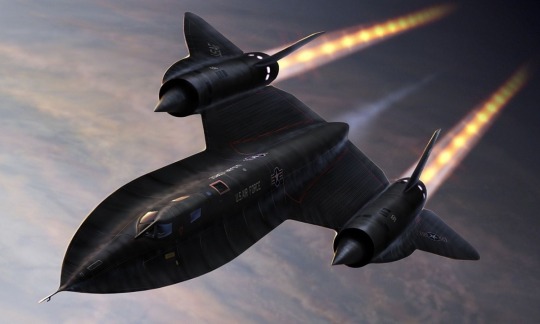
Blackbird pilot recalls when his SR-71 Flew so Fast that he and his RSO Landed at Beale AFB almost a Day Before They Took Off from Kadena AB
SR-71 Pilot tells the story of when his Blackbird flew So Fast that He and his RSO arrived at Beale AFB almost a Day Before They Left Kadena AB
The SR-71 Blackbird
The SR-71, the most advanced member of the Blackbird family that included the A-12 and YF-12, was designed by a team of Lockheed personnel led by Clarence “Kelly” Johnson, then vice president of Lockheed’s Advanced Development Company Projects, commonly known as the “Skunk Works” and now a part of Lockheed Martin.
SR-71 T-Shirts

CLICK HERE to see The Aviation Geek Club contributor Linda Sheffield’s T-shirt designs! Linda has a personal relationship with the SR-71 because her father Butch Sheffield flew the Blackbird from test flight in 1965 until 1973. Butch’s Granddaughter’s Lisa Burroughs and Susan Miller are graphic designers. They designed most of the merchandise that is for sale on Threadless. A percentage of the profits go to Flight Test Museum at Edwards Air Force Base. This nonprofit charity is personal to the Sheffield family because they are raising money to house SR-71, #955. This was the first Blackbird that Butch Sheffield flew on Oct. 4, 1965.
The Blackbird design originated in secrecy during the late 1950s with the A-12 reconnaissance aircraft that first flew in April 1962 and remained classified until 1976. President Lyndon Johnson publicly announced the existence of the YF-12A interceptor variant on Feb. 29, 1964, more than half a year after its maiden flight. The SR-71 completed its first flight on Dec. 22, 1964.
The Blackbird was designed to cruise at “Mach 3+,” just over three times the speed of sound or more than 2,200 miles per hour and at altitudes up to 85,000 feet.
Blackbird pilot recalls when his SR-71 Flew so Fast that he and his RSO Landed at Beale AFB almost a Day Before They Took Off from Kadena AB

David Peters in SR-71’s cockpit
The incredible speed of the SR-71 Blackbird
So, it comes as no surprise if, thanks to its astonishing flight characteristics, the aircraft has set numerous speed and altitude records throughout its career.
To give a real perspective of the incredible speed the iconic Blackbird could attain, SR-71 pilot David Peters tells the following, fabulous story.
‘We were TDY to Det. 1 at Kadena AB, Okinawa. One of the birds was scheduled for swap out and my back seater, Ed Bethart, and I were to fly it home. The replacement came in on Friday and we were to leave Saturday morning. So, in true Habu tradition we welcomed the incoming crew and went to happy hour Friday evening at the officers’ club.
SR-71 Pilot tells the story of when his Blackbird flew So Fast that He and his RSO arrived at Beale AFB 17 1/2 Hours Before They Left Kadena AB

David Peters and Ed Bethart
A true story
‘We got up Saturday morning and got ready to go home. Departure was scheduled for 1000. Everything went well and we departed right on time. Headed out to do a pass through the Korean DMZ then into the tankers in the Sea of Japan. Good refueling and climb out headed for the Sea of Okhotsk and the Kamchatka peninsula of Russia and from there to more tankers off of Adak in the Aleutian Islands. Another good refueling and on to Beale AFB California.
‘We arrived with a low approach pulled up into a closed pattern and landed. Following de-suiting and debrief we deposited our classified flight documents jumped in a car and arrived at the officers club for Friday night happy hour at 1630 17 1/2 hours before we left Kadena.
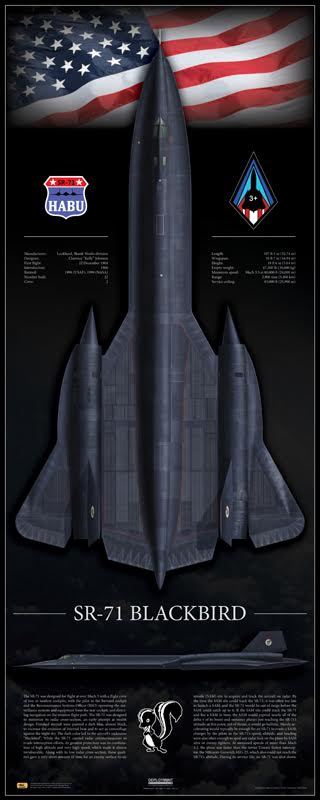
SR-71 print
This print is available in multiple sizes from AircraftProfilePrints.com – CLICK HERE TO GET YOURS. SR-71A Blackbird 61-7972 “Skunkworks”
‘Try that in any aircraft other than the SR-71. Besides this is actually a true story.’
Be sure to check out Linda Sheffield Miller (Col Richard (Butch) Sheffield’s daughter, Col. Sheffield was an SR-71 Reconnaissance Systems Officer) Twitter Page Habubrats SR-71 and Facebook Page Born into the Wilde Blue Yonder for awesome Blackbird’s photos and stories.
Photo credit: David Peters and U.S. Air Force
@Habubrats71 via X
244 notes
·
View notes
Note
Greetings! How true is that Yana is not involved in the writing of all events? Or is it only for the most recent one, Playful land? I'm a little confused.
Hello hello! Yana shares via Twitter what parts of what cards/events/stories/etc she was involved in every time something new is released, so I went through tweets from January of 2020 to November of 2023 to compare and contrast how she has described her role throughout the years, and compiled them here!
⚠️JP-server Only Visuals Spoiled Under the Cut⚠️
Vocabulary Review
・シナリオ: The English word “scenario,” this is an industry term that means “a written outline of a film, novel, or stage work giving details of the plot and individual scenes. It describes the sequence of scene changes, dialogue, and actions.” If Yana says she was in charge of the scenario for something, it is probably ok to assume that it was her project.
・原画(genga): The original artwork/initial visual concept upon which the final work was based

Ex: In this tweet Yana says she was in charge of the scenario, costume design and original card artwork for Fairy Gala.
・担当(tantou): The person in charge of something
・ディレクション: The English word “direction.”

Ex: In this tweet Yana says that she was in charge of direction for Malleus’ Birthday Jacket card.
・D-6th: This is Yana’s personal studio, which existed long before Twst and is also in charge of producing her manga (there seems to be a lot of overlap between the team that creates Black Butler and the Twst team, which she will sometimes reference in tweets). This seems to mean that there were multiple people involved in the creation process. It is unclear if she includes herself amongst the "D-6th" team, as sometimes she will specify that something was by her, something was by D-6th, or something was by both her and D-6th.
・弊社(heisha): a polite way of saying “my company,” this references Yana’s studio D-6th.

Ex: In this tweet Yana says that while she did the scenario herself, the backgrounds and prop designs were by her studio.
The Main Story
Starting with the release of part 1 of Book 3 on JP server, Yana explains that she did the scenario, original artwork for the SSR cards, directed the vignettes and was in charge of character design.

For Book 7 she says she did the scenario and original character art/character designs, while some prop designs and background visuals were done by her studio.
Card Art
For Ortho’s dorm uniform design Yana explains that both she and her studio did the original art from start to finish (she did the original concept and story for the vignette), while she alone was in charge of the before/after groovy art from start to finish for Idia’s dorm uniform card.

She did the art for Leona and Riddle’s tsumsted cards (and direction for the other cards in the series), Sebek’s dorm uniform art from start to finish and and did art direction for the cards in the 2022 New Year’s set, while costume design was done by her studio.
Rook’s Clubwear, Ortho’s Cerberus Gear, Lilia’s General card, Rollo’s card and Grim’s D100 card are all credited to both Yana and her studio.

(We got a rare comment with the release of Ortho’s Cerberus Gear where she said, “We have an artist working with us who spent almost 20 years doing backgrounds for a certain, extremely famous robot anime. She oversees a lot of the background art designing. The background for Ortho’s Cerberus Gear card, the aircraft catapult, the facility seen in the groovy art—that is all her work. It really captures the moment of take off! Professional background artists are truly amazing, capable of designing everything from S.T.Y.X.’s futuristic aircraft catapult to homages of famous watercolor masterpieces." That is one of the artists that Yana is referring to when a design is attributed to D-6th.)
Birthdays

Yana was credited with direction for the Birthday Boy series, while Ortho’s design and direction was credited to her studio.

Yana credited her studio with the Birthday Jacket designs and scenario creation, saying that she was in charge of direction for the series (with Ortho’s gear design, direction and room design all credited to her studio).

For the Broom/Bloom series Yana says that she participated in concept/costume design and was in charge of direction (with D-6th credited with the art direction and gear design for Ortho).

The art for the platinum series (including the backgrounds) is credited to the staff of D-6th, with Yana in charge of direction.
Events
Yana explains she did all the original art for all of the cards, the scenarios and direction for Beanfest, Fairy Gala and Phantom Bride (she also created the scenarios for all the vignettes).

She also created the story and did all of the card art and direction for Terror is Trending and Spectral Soiree.
For Port Fest she specified that she did the original art for Jack’s SSR and did direction for the remaining cards, crediting her studio with costume/background designs.
Yana created the scenario, character design, SSR card art (from start to finish) and did art direction for the R and SR cards of Glorious Masquerade, crediting herself and her studio with the costume/mask designs, background designs, and opening and ending screens.
She says she participated in card art direction for the R and SR cards in the Lost in the Book with Stitch event, crediting the costume designs, scenario creation, background visuals, SSR Lilia, SSR Floyd, original card art and creation to her studio.

Stage in Playfulland character design, costume design, scenario creation, card art direction, background visuals and Opening/Ending art are also all credited to her studio.
(To answer the initial question: the only difference seems to be that Playfulland is credited entirely to her studio without Yana specifying how she was involved, whereas she took credit for the scenario writing in Glorious Masquerade, Spectral Soiree and Terror is Trending. While not the first time this has happened in the game (Yana also did not specify her role in the Tamashina Mina event, attributing costume design, background visuals, the Opening/Ending, the setting/card art direction and character design only to D-6th), this was the first time it’s happened with a Halloween event.)
Novel

Yana says she was in charge of the concept, the in-novel art, cover and fold-out art in the novels, while Hioki Jun (a Twst vignette/event scenario writer) created the novel scenarios.
Comic

The artist and designer behind the 1st and 3rd comic arcs are both from Yana’s studio D-6th, doing background and card art for Twst (and work on Black Butler).
Yana says that her role is overall collaboration, character design and character creation (she says that in addition to creating the basis for Trey’s parents she also designed Riddle’s mother, including her face, but they ultimately left her in silhouette).
It is difficult to tell what Yana means by “overall collaboration," but she has shared a tweet about drawing the characters out herself for the actual artists to base their work on. (This might not apply to the artist of the Savanaclaw arc, who is not a member of D-6th)
262 notes
·
View notes
Text

1956 Oldsmobile Golden Rocket
Bullet on Wheels: The 1956 Oldsmobile Golden Rocket
Easily one of the wildest General Motors dream cars of the Motorama era, the Olds Golden Rocket was the epitome of Jet Age design. Let’s take a closer look.
Throughout the 1950s, Harley Earl and his forward-looking crew at the GM styling studios frequently turned to aircraft and space travel for their inspiration. There might be no better example of the automaker’s guided-missile design theme than the far-out Golden Rocket, Oldsmobile’s Motorama dream car for 1956. “The Supersonic Age comes to automobile styling!” the company proclaimed.

1956 Oldsmobile Golden Rocket
Constructed in fiberglass on a shortened Oldsmobile passenger car perimeter frame with a 105-inch wheelbase, the Golden Rocket was essentially a bullet on wheels in side view (above.) But under the skin, the show car was fairly conventional with a 324 CID, 275-horsepower Olds Rocket V8 up front, Hydra-Matic automatic transmission, and leaf-spring rear suspension. The custom wheels employed integral brake drums, and a pair of fuel tanks were housed in the rear fenders. Note the “dotted-line” segmented whitewalls, a novel feature that never went any further.
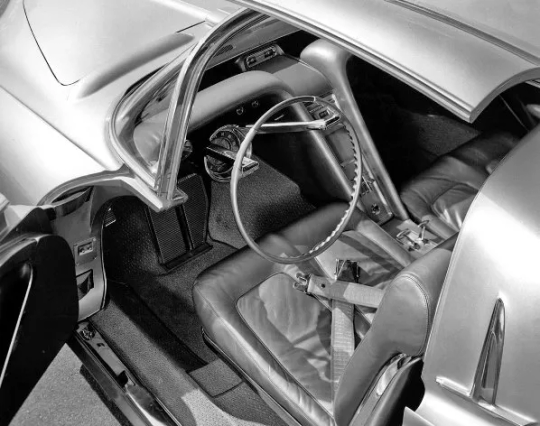
1956 Oldsmobile Golden Rocket
At a little more than 200 inches long but less than 50 inches tall, the Rocket sported an impressively low silhouette, which required some ingenuity in the packaging of the two-seat cabin. For easier entry and egress, a roof panel popped up when the door was opened on either side, while the steering wheel rim swung upward and the bucket seats rose three inches and pivoted on their mountings. Upholstery was blue and gold leather, while the speedometer was housed in the steering wheel hub. The lap belts and driver pedals display a strong aircraft influence.
While the Rocket seems to be one of the more obscure GM dream cars in current times, it did include some ideas that turned up later on the General’s production models. The stubby rocket-type tailfins would adorn some memorable Cadillacs of the early ’60s, while the split-window teardrop rear window is extremely familiar. It was next tried on a dead-ended 1958 Corvette styling proposal, then famously appeared on the 1963 Corvette Sting Ray coupe. As with a number of GM Motorama dream cars, the fate of the Golden Rocket was not officially documented, reportedly, but it hasn’t been seen or heard from in years and is presumed destroyed.

1956 Oldsmobile Golden Rocket
137 notes
·
View notes
Text
It's cute to say that stealth aircraft got rounder for the same reason that video game characters did: because the computers got more powerful. But it's not the completely story. More accurately, it was specifically Lockheed's stealth aircraft that evolved that way.
Famously, a Lockheed employee noticed a paper describing how to calculate electromagnetic scattering from a polyhedron. They implemented it in software and used it to design the Have Blue demonstrator, which evolved into the F-117.
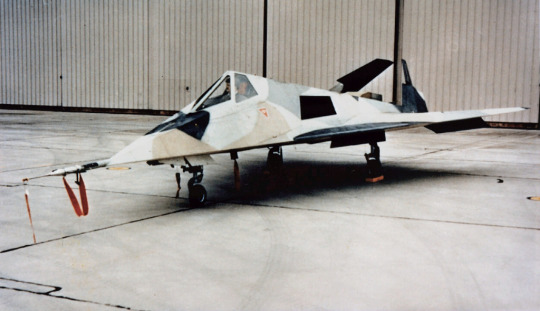
But at the same time, Northrop developed the Tacit Blue demonstrator, which was not designed using the edge diffraction software, and did not consist of only flat polygons.

Tacit Blue was the first aircraft to use "edge convolution" (a.k.a. "Gaussian stealth"). This smoothes out the edges by convolving them with a gaussian function. In particular, the convolution makes the edge of the wing sharper than if it was just a wedge between two polygons (with an ideal gaussian function it would extend out infinitely, so the acute angle would approach 0 degrees). This means that the edge of the wing will reflect less radar waves if it is illuminated directly from the side (from the horizon), which is the typical case if the plane is flying straight and the enemy radar is far away.

All stealth aircraft now use the gaussian smoothing idea, and you can clearly see the commonalities between Tacit Blue and the Northrop B-2.
Actually, when it came time to design the ATF (which evolved into the F-22), Lockheed also had to abandon their edge diffraction software. The ATF chief engineer commented:
We did not know how to analyze a curved stealthy shape in those days. The software wasn't sophisticated enough, and we didn't have the computational capacity we needed. We had our hands tied by the analytical problems. Lockheed had become convinced that, if we could not analyze a design as a stealthy shape, then it could not be stealthy. We would not break through that barrier until 1984. [...] We simply started drawing curved shapes even though we could not run the designs through our analytical software models. When we went to curved airplanes, we began to get more acceptable supersonic and maneuver performance. Instead of relying on software models, we built curved shapes and tested them on the company's radar range. The curved shapes performed quite well in the radar tests.
So in the end, I think the "smooth stealth planes" (B-2, F-22) were mainly designed heuristically and evaluated by building actual model airplanes; having fast computers to simulate them was not the bottle neck.
134 notes
·
View notes
Text
According to research by the Campaign Against the Arms Trade (CAAT), the UK has licensed more than £472 million in arms exports to Israel since 2015. This includes tank components, armour-piercing ammunition and small arms, but, in keeping with the structure of the British weapons industry, aerospace components for fighters and drones predominate. It’s difficult to get clear numbers from the arms industry. The headline figure is taken from the value of standard licences, but the UK also operates a system of open licences that permit transfers of unlimited – and unspecified – quantities of particular military goods. Since 2015, 57 such licences have been granted for export to Israel, ten of those in 2022. They include British components for the American-designed F-35 aircraft, which campaigners estimate have been worth £336 million to the companies (primarily BAE Systems) producing them. Because the quantities of goods issued under open licences are not made public, groups such as CAAT have to back-engineer their value. In recent years the government has become increasingly hostile to Freedom of Information requests on arms, but there is enough publicly available data to be certain that the planes currently flattening apartment blocks and refugee camps in Gaza rely on components engineered and manufactured in Britain.
There is little appetite in Westminster for reform of the domestic arms industry. For one thing, it is a rare economic success story. The UK is the second largest exporter of defence items in the world and, according to the Stockholm International Peace Research Initiative, the sixth largest exporter of major conventional weapons (which means everything short of weapons of mass destruction), primarily aircraft. The total value of standard licences issued in 2021 was £10.7 billion, and the industry depends on its aerospace sector, which accounts for 72 per cent of export business. More than half of all British defence exports go to the Middle East – but to Saudi Arabia rather than Israel. Human rights organisations, including Amnesty International, accuse BAE Systems of being party to Saudi war crimes in Yemen, where BAE-supplied (and serviced) fighters have bombed schools and hospitals.
James Butler, Up in Arms
123 notes
·
View notes
Text
Something I noticed when reading Vol.9 of Spy X Family was this vehicle that I recognized because I love it:

The car that the Forgers are in here seems to be based on a Messerschmitt Kabinenroller(a Messerschmitt Cabin Scooter)! Wikipedia calls it a micro car but Cabin Scooter really is more accurate as it is just an enclosed motorcycle. The car was manufactured from 1953 to 1964 by the Messerschmitt company in Germany. The car was a massive hit in post war Germany and is an iconic part of the era. My grandfather owned one in the 50s and said that he often overtook over cars including Porsches, this is not that surprising given that Messerschmitt was actually an aerospace manufactured that designed the Kabinenroller after WWII due to not being allowed to manufacture aircraft(fair honestly) so engineers used their expertise for lighter frames and fast engines to build this.
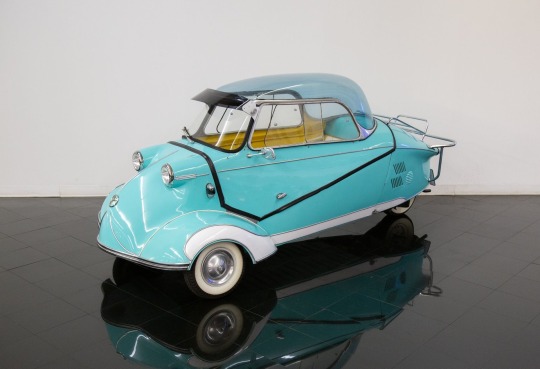
It’s probably my favorite motor vehicle-only partly cause of the potential ease of parking-and I was happy to see it featured. This is just another aesthetic reference that SxF makes to 1950s/1960s Germany.
147 notes
·
View notes
Text
Remember that 737 MAX whose door plug blew out in flight?
A boeing whistleblower created a burner account and reported the following (reproduced here in its entirety in case the original gets deleted):

Current Boeing employee here – I will save you waiting two years for the NTSB report to come out and give it to you for free: the reason the door blew off is stated in black and white in Boeings own records. It is also very, very stupid and speaks volumes about the quality culture at certain portions of the business.
A couple of things to cover before we begin:
Q1) Why should we believe you?
A) You shouldn’t, I’m some random throwaway account, do your own due diligence. Others who work at Boeing can verify what I say is true, but all I ask is you consider the following based on its own merits.
Q2) Why are you doing this?
A) Because there are many cultures at Boeing, and while the executive culture may be throughly compromised since we were bought by McD, there are many other people who still push for a quality product with cutting edge design. My hope is that this is the wake up call that finally forces the Board to take decisive action, and remove the executives that are resisting the necessary cultural changes to return to a company that values safety and quality above schedule.
With that out of the way… why did the left hand (LH) mid-exit door plug blow off of the 737-9 registered as N704AL? Simple- as has been covered in a number of articles and videos across aviation channels, there are 4 bolts that prevent the mid-exit door plug from sliding up off of the door stop fittings that take the actual pressurization loads in flight, and these 4 bolts were not installed when Boeing delivered the airplane, our own records reflect this.
The mid-exit doors on a 737-9 of both the regular and plug variety come from Spirit already installed in what is supposed to be the final configuration and in the Renton factory, there is a job for the doors team to verify this “final” install and rigging meets drawing requirements. In a healthy production system, this would be a “belt and suspenders” sort of check, but the 737 production system is quite far from healthy, its a rambling, shambling, disaster waiting to happen. As a result, this check job that should find minimal defects has in the past 365 calendar days recorded 392 nonconforming findings on 737 mid fuselage door installations (so both actual doors for the high density configs, and plugs like the one that blew out). That is a hideously high and very alarming number, and if our quality system on 737 was healthy, it would have stopped the line and driven the issue back to supplier after the first few instances. Obviously, this did not happen. Now, on the incident aircraft this check job was completed on 31 August 2023, and did turn up discrepancies, but on the RH side door, not the LH that actually failed. I could blame the team for missing certain details, but given the enormous volume of defects they were already finding and fixing, it was inevitable something would slip through- and on the incident aircraft something did. I know what you are thinking at this point, but grab some popcorn because there is a plot twist coming up.
The next day on 1 September 2023 a different team (remember 737s flow through the factory quite quickly, 24 hours completely changes who is working on the plane) wrote up a finding for damaged and improperly installed rivets on the LH mid-exit door of the incident aircraft.
A brief aside to explain two of the record systems Boeing uses in production. The first is a program called CMES which stands for something boring and unimportant but what is important is that CMES is the sole authoritative repository for airplane build records (except on 787 which uses a different program). If a build record in CMES says something was built, inspected, and stamped in accordance with the drawing, then the airplane damn well better be per drawing. The second is a program called SAT, which also stands for something boring and unimportant but what is important is that SAT is *not* an authoritative records system, its a bullentin board where various things affecting the airplane build get posted about and updated with resolutions. You can think of it sort of like a idiots version of Slack or something. Wise readers will already be shuddering and wondering how many consultants were involved, because, yes SAT is a *management visibilty tool*. Like any good management visibilty tool, SAT can generate metrics, lots of metrics, and oh God do Boeing managers love their metrics. As a result, SAT postings are the primary topic of discussion at most daily status meetings, and the whole system is perceived as being extremely important despite, I reiterate, it holding no actual authority at all.
We now return to our incident aircraft, which was written up for having defective rivets on the LH mid-exit door. Now as is standard practice kn Renton (but not to my knowledge in Everett on wide bodies) this write-up happened in two forms, one in CMES, which is the correct venue, and once in SAT to “coordinate the response” but really as a behind-covering measure so the manager of the team that wrote it can show his boss he’s shoved the problem onto someone else. Because there are so many problems with the Spirit build in the 737, Spirit has teams on site in Renton performing warranty work for all of their shoddy quality, and this SAT promptly gets shunted into their queue as a warranty item. Lots of bickering ensues in the SAT messages, and it takes a bit for Spirit to get to the work package. Once they have finished, they send it back to a Boeing QA for final acceptance, but then Malicious Stupid Happens! The Boeing QA writes another record in CMES (again, the correct venue) stating (with pictures) that Spirit has not actually reworked the discrepant rivets, they *just painted over the defects*. In Boeing production speak, this is a “process failure”. For an A&P mechanic at an airline, this would be called “federal crime”.
Presented with evidence of their malfeasance, Spirit reopens the package and admits that not only did they not rework the rivets properly, there is a damaged pressure seal they need to replace (who damaged it, and when it was damaged is not clear to me). The big deal with this seal, at least according to frantic SAT postings, is the part is not on hand, and will need to be ordered, which is going to impact schedule, and (reading between the lines here) Management is Not Happy. 1/2
2/2
However, more critical for purposes of the accident investigation, the pressure seal is unsurprisingly sandwiched between the plug and the fuselage, and you cannot replace it without opening the door plug to gain access. All of this conversation is documented in increasingly aggressive posts in the SAT, but finally we get to the damning entry which reads something along the lines of “coordinating with the doors team to determine if the door will have to be removed entirely, or just opened. If it is removed then a Removal will have to be written.” Note: a Removal is a type of record in CMES that requires formal sign off from QA that the airplane been restored to drawing requirements.
If you have been paying attention to this situation closely, you may be able to spot the critical error: regardless of whether the door is simply opened or removed entirely, the 4 retaining bolts that keep it from sliding off of the door stops have to be pulled out. A removal should be written in either case for QA to verify install, but as it turns out, someone (exactly who will be a fun question for investigators) decides that the door only needs to be opened, and no formal Removal is generated in CMES (the reason for which is unclear, and a major process failure). Therefore, in the official build records of the airplane, a pressure seal that cannot be accessed without opening the door (and thereby removing retaining bolts) is documented as being replaced, but the door is never officially opened and thus no QA inspection is required.
This entire sequence is documented in the SAT, and the nonconformance records in CMES address the damaged rivets and pressure seal, but at no point is the verification job reopened, or is any record of removed retention bolts created, despite it this being a physical impossibility. Finally with Spirit completing their work to Boeing QAs satisfaction, the two rivet-related records in CMES are stamped complete, and the SAT closed on 19 September 2023. No record or comment regarding the retention bolts is made.
I told you it was stupid.
So, where are the bolts? Probably sitting forgotten and unlabeled (because there is no formal record number to label them with) on a work-in-progress bench, unless someone already tossed them in the scrap bin to tidy up.
There’s lots more to be said about the culture that enabled this to happened, but thats the basic details of what happened, the NTSB report will say it in more elegant terms in a few years.
73 notes
·
View notes
Text

SEATTLE, WA — Amid growing concerns over safety after several devastating mechanical failures on Boeing 737-9 Max aircraft, Boeing CEO Dave Calhoun assured hesitant travelers that all their aircraft are built according to the highest standards of diversity.
"I know everyone is nervous about the doors of their planes blowing off the aircraft mid-flight or the entire fuselage buckling due to faulty parts, but let me assure you: Boeing is diverse," said Calhoun in a CNBC interview. "In fact, our design and manufacturing crews are the most diverse in our company's history. Nothing to worry about."
Boeing is facing NTSB investigations after several mechanical failures that caused Alaska Airlines to ground all 737-9 Max aircraft. Calhoun said such concerns are unwarranted. "We have women, people of color, and even autistic paraplegics working on the 737," he said. "There's nothing safer than a plane built by diversity!"
At publishing time, 3 more airlines had grounded the aircraft, likely because they hate diversity.
58 notes
·
View notes
Text
• The desire to push R&D costs off to the company’s suppliers meant that Boeing was essentially building its planes from kits that weren’t designed together, didn’t fit together, and didn’t meet the standard of quality the company had once been known for. This move may have been a short-term boon for company profits, the share price, or for CEO bonuses, but the reduction in quality has given rise to the phrase “If it’s a Boeing, I ain’t going.” I’m not sure there has ever been a more aggressive about-face on a company’s view by the global public. •
===================================
The problems are Systemic and require an expensive, extensive, and prolonged effort to correct.
Tying bonuses to safety - as announced by Boeing - ignores the potential and now realized Systemic catastrophes possiblities when mating components designed by different manufacturering entities. (As opppsed to subcontractors manufacturing to specifications and blueprints produced by Boeing.
The different components may all pass their individually manufacturers quality control as well as Boeing’s. As INDIVIDUAL components but FAIL to mesh in the completed aircraft.
The burgeoning examples are coming faster and faster. Executives aren’t going to solve these known issues let along figure out other weaknesses if Boeing has lost depth in engineering staff.
What a nightmare.
42 notes
·
View notes
Note
What kind of work can be done on a commodore 64 or those other old computers? The tech back then was extremely limited but I keep seeing portable IBMs and such for office guys.
I asked a handful of friends for good examples, and while this isn't an exhaustive list, it should give you a taste.
I'll lean into the Commodore 64 as a baseline for what era to hone in one, let's take a look at 1982 +/-5 years.
A C64 can do home finances, spreadsheets, word processing, some math programming, and all sorts of other other basic productivity work. Games were the big thing you bought a C64 for, but we're not talking about games here -- we're talking about work. I bought one that someone used to write and maintain a local user group newsletter on both a C64C and C128D for years, printing labels and letters with their own home equipment, mailing floppies full of software around, that sorta thing.
IBM PCs eventually became capable of handling computer aided design (CAD) work, along with a bunch of other standard productivity software. The famous AutoCAD was mostly used on this platform, but it began life on S-100 based systems from the 1970s.
Spreadsheets were a really big deal for some platforms. Visicalc was the killer app that the Apple II can credit its initial success with. Many other platforms had clones of Visicalc (and eventually ports) because it was groundbreaking to do that sort of list-based mathematical work so quickly, and so error-free. I can't forget to mention Lotus 1-2-3 on the IBM PC compatibles, a staple of offices for a long time before Microsoft Office dominance.
CP/M machines like Kaypro luggables were an inexpensive way of making a "portable" productivity box, handling some of the lighter tasks mentioned above (as they had no graphics functionality).
The TRS-80 Model 100 was able to do alot of computing (mostly word processing) on nothing but a few AA batteries. They were a staple of field correspondence for newspaper journalists because they had an integrated modem. They're little slabs of computer, but they're awesomely portable, and great for writing on the go. Everyone you hear going nuts over cyberdecks gets that because of the Model 100.
Centurion minicomputers were mostly doing finances and general ledger work for oil companies out of Texas, but were used for all sorts of other comparable work. They were multi-user systems, running several terminals and atleast one printer on one central database. These were not high-performance machines, but entire offices were built around them.
Tandy, Panasonic, Sharp, and other brands of pocket computers were used for things like portable math, credit, loan, etc. calculation for car dealerships. Aircraft calculations, replacing slide rules were one other application available on cassette. These went beyond what a standard pocket calculator could do without a whole lot of extra work.
Even something like the IBM 5340 with an incredibly limited amount of RAM but it could handle tracking a general ledger, accounts receivable, inventory management, storing service orders for your company. Small bank branches uses them because they had peripherals that could handle automatic reading of the magnetic ink used on checks. Boring stuff, but important stuff.
I haven't even mentioned Digital Equipment Corporation, Data General, or a dozen other manufacturers.
I'm curious which portable IBM you were referring to initially.
All of these examples are limited by today's standards, but these were considered standard or even top of the line machines at the time. If you write software to take advantage of the hardware you have, however limited, you can do a surprising amount of work on a computer of that era.
44 notes
·
View notes
Photo
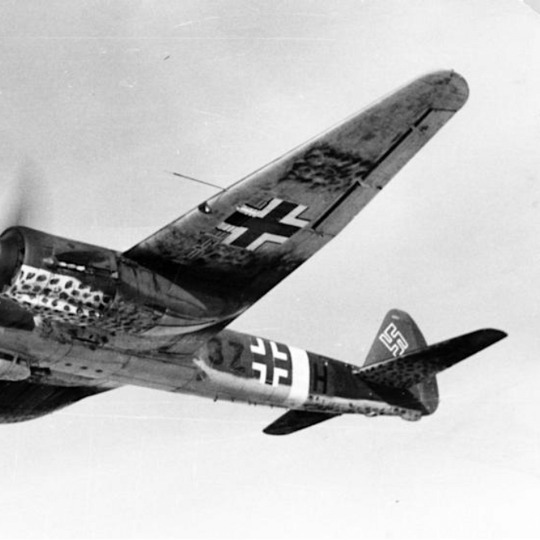
Junkers Ju 88
The Junkers Ju 88 was a two-engined medium bomber plane used by the German Air Force (Luftwaffe) throughout the Second World War (1939-45). Ju 88s were involved in the Battle of Britain and London Blitz as bombers, but this versatile aircraft saw action in many other theatres of the war, primarily as a dive bomber and a night fighter.
Design Development
After much debate between the German high command and the Nazi leader Adolf Hitler (1889-1945), the Luftwaffe bomber command (Kampfwaffe) was obliged to adopt the position that bombers should primarily be used strategically to assist ground troops. This meant that unlike, say, the British Royal Air Force, the Luftwaffe concentrated not on heavy bombers but building squadrons of more versatile medium bombers.
In August 1935, aeronautical companies were invited to provide an answer to the German Air Force's requirement for a two-engined, medium-sized and high-speed bomber (Schnellbomber). Junkers came up with the Junkers 88, with various prototypes given a V designation plus a number 1 to 5. The first prototype, the Ju 88 V1, flew in December 1936 and impressed with its high speed. By March, the Ju 88 V5 was capable of speeds of over 300 mph (500 km/h) and so broke several records.
The decision in 1937 to give the Ju 88 a dive-bombing capability meant that the design process now became fraught with delays and constant revisions. As the historian J. Holland notes, "some 25,000 changes were made to the original design" (216). Most significant of these changes, perhaps, was the strengthening of the wings to take the force which resulted from steep dives, the addition of brakes to arrest the plane at the nadir of the dive, and the lengthening of the fuselage to admit extra crew members. The consequence of all this was that the plane ended up being much heavier and slower than the original plan, a situation that led Field Marshall Erhard Milch (1892-1972), one of the founders of the Luftwaffe, to disparagingly describe the Ju 88 as a "flying barn door" (ibid). The problems of weight and speed were partially alleviated by adding rocket boosters for takeoff when carrying heavier bomb loads. The design changes kept on coming, too, notably an increase in the wingspan. As a result of the complex design, the Ju 88 took more time to build than many other aircraft types.
Introduced into Luftwaffe service in September 1939, just as WWII started, the Ju 88s' challengers as the medium bomber of choice within the Luftwaffe were the antiquated and poorly armed Dornier Do 17, the equally vulnerable but faster Dornier Do 215, and the tried and tested Heinkel He 111, which was overall the best of the three at the beginning of the war. The Junkers Ju 88 was smaller than the other three medium bombers but faster than the He 111 and the Do 17, and yet it was capable of carrying as heavy a bomb load as the He 111. As a consequence, gradually the Ju 88 took over from the He 111 as the bomber of choice but both saw service right through the war. All of these planes had two engines, which fundamentally restricted their bomb loads and range compared to Allied heavy bombers like the B-17 Flying Fortress and Avro Lancaster bomber.
The upside of its checkered design history was that the 1940 version of the Ju 88 was more versatile than originally planned, making it perhaps the most versatile of any aircraft of any air force in WWII. The Ju 88 could perform as a bomber, dive-bomber, and night fighter. Other duties performed by the Ju 88 included long-range reconnaissance (when they were fitted with extra fuel tanks, radar, and cameras), attacking shipping, and minelaying at sea. Finally, one distinct advantage of the Ju 88 was that its frame was built in such a way that it could withstand tremendous punishment from enemy fire. Factories dedicated to Ju 88 production included those at Brünn (now Brno in the Czech Republic) and Graz and Vienna in Austria. Air forces which operated Ju 88s besides the Luftwaffe included the Finnish, French, Hungarian, Italian, and Romanian.
Continue reading...
20 notes
·
View notes